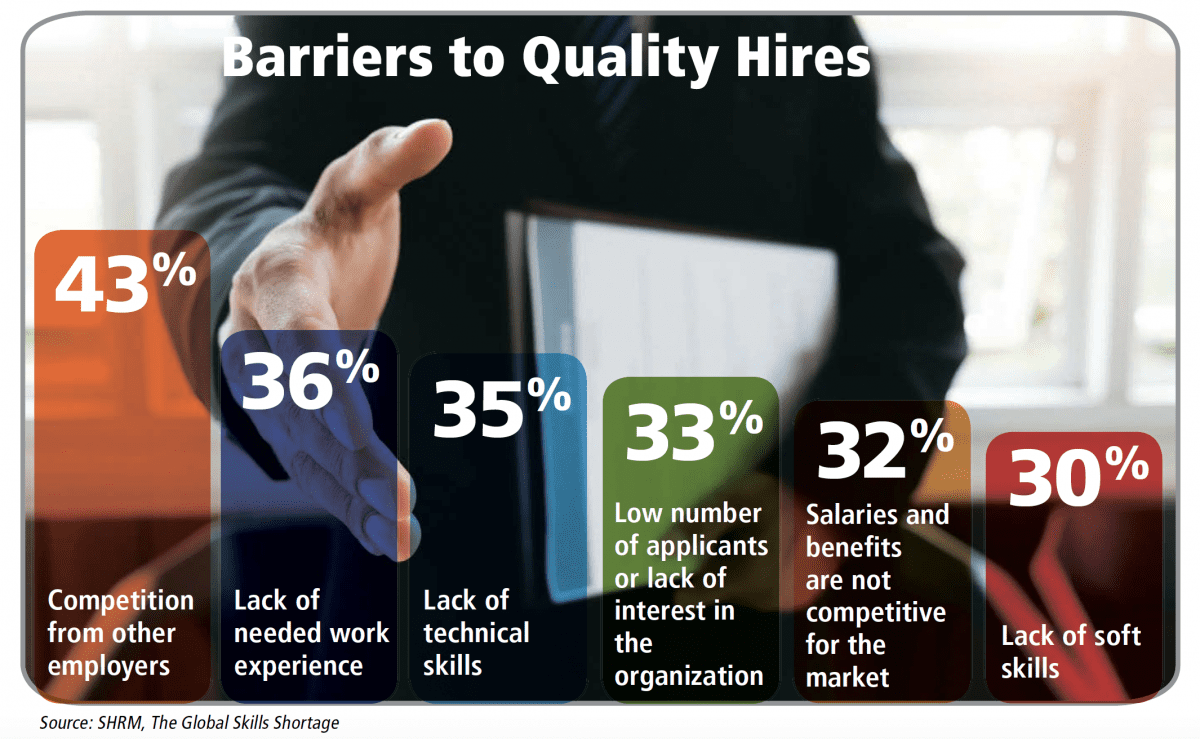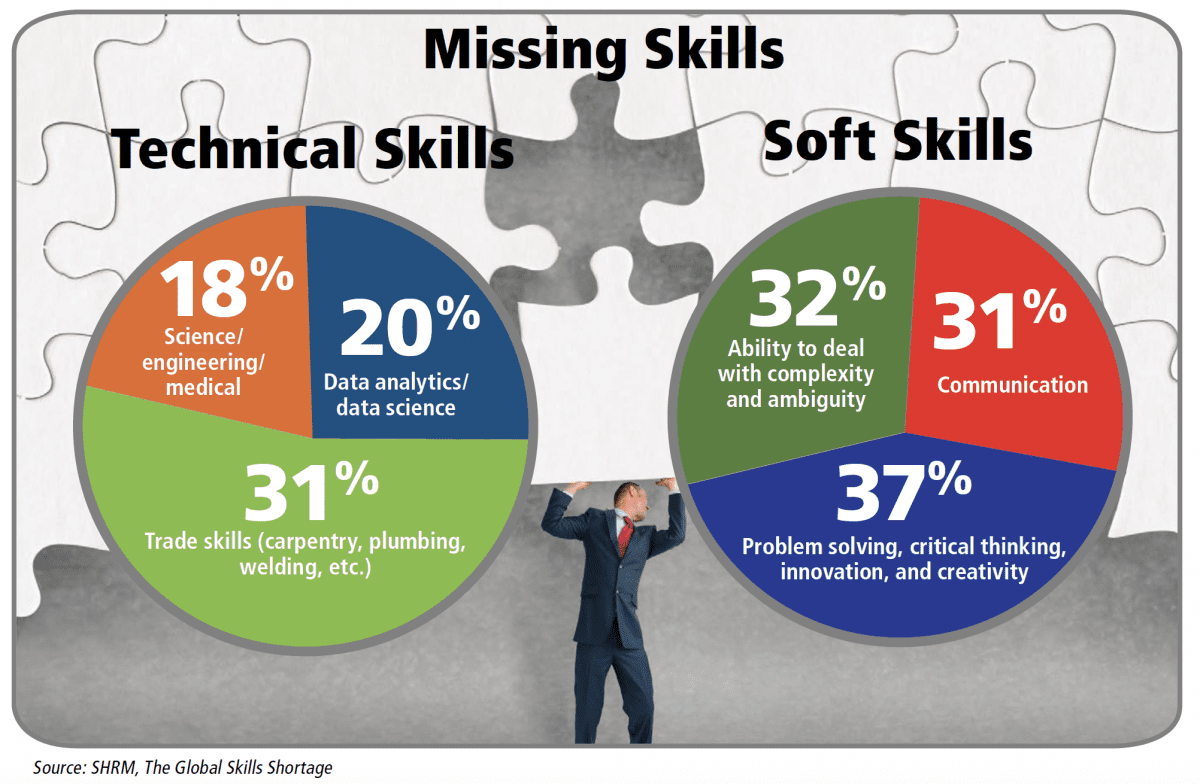In a tight labor market, organizations are looking from within to fill talent shortages.
By Marta Chmielowicz
Today’s job market is plagued with skills shortages. According to SHRM’s The Global Skills Shortage study, 83 percent of HR professionals have had trouble recruiting suitable candidates in the past 12 months, and 75 percent of these struggling leaders attribute their difficulties to a lack of available skills. The country is also facing full employment: In December 2018, there were 7 million open jobs in the U.S. but only 6.3 million unemployed people looking for work.
The accelerating pace of technological change is exacerbating the talent dilemma, shortening the shelf life of skills and shifting the demands of work in the digital age. “Most industries are introducing new digital tools and automation to free up employees’ time to focus on more strategic tasks and innovation,” says Mike Hughes, managing director at West Monroe Partners. “In fact, our recent research found that 70 percent of companies have introduced at least one new form of technology in the last 12 months to increase employee capacity.”
While companies offer training on how to use these tools, they often neglect to develop the problem-solving, strategic thinking, and communication skills needed to leverage the technologies to their full capacity, further contributing to skills shortages. According to Craig Sweeney, senior vice president of global strategic talent solutions at WilsonHCG, this imbalance of supply and demand results in an ultra-competitive talent market where recruiters cannot rely on passive, brand-based attraction -they need to work harder to actively engage job seekers, driving up the cost of recruitment.
“With such a competitive talent market, companies should be looking inward and focusing on upskilling and reskilling their current employees to fill gaps that might be difficult or costly to source,” Hughes says. “You can upskill a resource at approximately one-third of the cost of hiring. It costs an average of $1,300 to upskill versus $4,425 to hire.”
By reskilling their talent, companies not only save money, but they ensure that they develop the skill sets and behaviors that they need for the future in employees who are already aligned to the organization’s culture.
Employers have begun to make efforts to develop their workforce’s skills but more progress is needed. To close the skills gap, HR leaders need to analyze the needs of their business and develop remedies, whether it’s offering new courses for high-potential employees, fostering partnerships with educational institutions, or designing rotational training programs for foreign-born talent. An RPO provider can help determine the best course of action and outline steps for implementation.
While RPO companies are not necessarily delivering learning solutions, the consultative services and access to data that they offer can help organizations identify their skill gaps and develop strategies to fill them. Terri Lewis, senior vice president and global head of HR at Pontoon, says that the historical data, skills analyses, market information, and demand planning that RPO providers offer all combine into a comprehensive overview of the business that can then be aligned with organizational goals and forecasts to guide strategy.
Combining TA and L&D
Identifying high potentials and creating concrete workforce planning strategies is critical to a successful upskilling approach.
Organizations should “build out programs to identify top-performing internal talent and put those people on accelerated development tracks with additional continued learning programs for upskilling,” advises Chip Holmes, client portfolio leader at PeopleScout, adding that TA leaders should also keep a close eye on candidates with a growth mindset and a track record of career elasticity.
Roger Casalengo, senior vice president and CHRO of Cobham Advanced Electronic Solutions (CAES), says that talent planning is a key priority for his business. He has partnered with the vice president of engineering to design a strategic workforce plan for the recruitment and development of the company’s engineering workforce, addressing everything from recruitment strategies to upskilling, knowledge transfer, and technology gaps.
Part of this process involved outlining a specific talent journey for each leadership position that employees can consult to guide their career growth. CAES handled this by engaging the total rewards leader and talent management leader to define exact job descriptions, hierarchy levels, and skill sets needed for each role.
“If an employee comes into CAES at an entry level role, he or she will be able to see their career path to senior level roles if they choose. Also, they have development classes and learnings associated with each core competency they’ll need to learn in order to be competitive for any opportunities they are interested in for their career,” Casalengo says.
In this type of strategy, collaboration between the various sides of the business is key to a successful result. Sweeney says that while recruitment and L&D professionals currently tend to operate independently, with TA focused on external talent and L&D focused on internal talent, their common goals will enable them to build a stronger partnership in the future.
“The starting point is understanding first and foremost what the business objectives are and what the organization is trying to achieve,” he explains. “Both TA and L&D have a common goal: to make the organization better through talent. Those parts of the business will work more closely together to better understand what the future business plan looks like so that they can identify how much talent they need to acquire and develop, and potentially look at future upskilling when there’s a shortage of talent that will not be readily available at the scale they need. Once you identify those gaps, it becomes part of the development of your future talent pipeline. You can start to identify which groups you need to engage in which locations.”
Casalengo says that at his organization, the effort to be more collaborative begins with the executive team. Like a great jazz band, the leaders at CAES play off each other’s individual styles and initiatives, acknowledging the co-dependency of each program and working together to understand blind spots and prepare for challenges. The C-suite even goes so far as to involve managers in their workforce planning efforts, leveraging their expertise to better understand the employee experience.
By listening to the feedback of managers, business leaders can get a more direct view of employees’ needs when crafting a talent strategy. Hughes suggests that this perspective is essential, for a good learning approach needs to be developed with employees at its center. “This means proactively considering how a new process or tool will impact employees’ dayto- day lives through conversation and collaboration, establishing a change management strategy alongside implementations, and being sure to pivot based on the collection of ongoing feedback,” he adds.
Pontoon’s Lewis says that if HR business partners, workforce planning professionals, procurement, and business leaders work together to develop a well-rounded strategy, an organization will be able to leverage all of its resources to fill future talent needs.
The Power of Data
Embracing an agile talent approach will also prove beneficial in a tight talent market. Sweeney recommends that organizations leverage market data to identify what talent they need and where that talent exists in the global marketplace. With this information in hand, companies can better target their talent strategies, upskilling or relocating needed employees in areas where there is a skills shortage. Lewis agrees that historical data, skills analyses, market information, and demand planning can help build talent forecasts to guide the right approach.
CAES’ global strategies include adopting a tool that shows market pay rates for each geographical region. “At any given time, we can determine if a particular job is heating up in the workforce or a location is paying more for certain skill sets, and we’re able to adjust quickly,” says Casalengo. “Being nimble and agile in the workforce today around career growth and career pay is critical for our success.”
The company also has processes in place that allow it to move talent quickly within the organization, encouraging short-term relocations that develop skills and increase collaboration. This initiative, or “borderless engineering,” allows the organization to leverage its skilled engineers across the world, keeping top talent engaged while developing less skilled employees.
And the borderless approach doesn’t end there: “Technical fellows,” or subject matter experts in their field or discipline, are encouraged to provide consulting support on tough challenges across the organization, not just at their base location.
Educational Connections and Apprenticeships
Fostering educational partnerships can help fill skills gaps by developing both current and future talent. Collaborating with universities and colleges can bring new knowledge to an organization, says Lewis. “[Learning partnerships] can include on-demand learning pathways, online courses, on-campus courses, workshops, skills training, and certifications to name a few. These can be embedded into an organization as part of its L&D strategy,” she explains. “RPO partners can also support internships, apprenticeships, referral communities, and rotational training programs.”
How is this accomplished? According to PeopleScout’s Holmes, RPO providers leverage their knowledge of the employment market to identify the most relevant schools for their clients’ specific needs. Once they identify best-fit campus programs, the organizations work to strengthen the relationships between their clients and those institutions, leveraging the alumni network and employer branding to attract employable graduates with the needed skill sets.
For example, Holmes says that one leader in the banking industry has a strong partnership with a university that produces graduates with growth mindsets and industry-relevant skills. The bank enhances its employer value proposition by offering a learning program that encourages graduates to grow further, cementing itself as an employer of choice.
CAES has done something similar in its New Hampshire location. “We piloted an apprenticeship program in New Hampshire with state support. We’ve been able to matriculate these graduates into the organization at tough-to-fill skill roles. We are getting ready to adopt the successful pilot in all our locations in 2020,” Casalengo says.
















